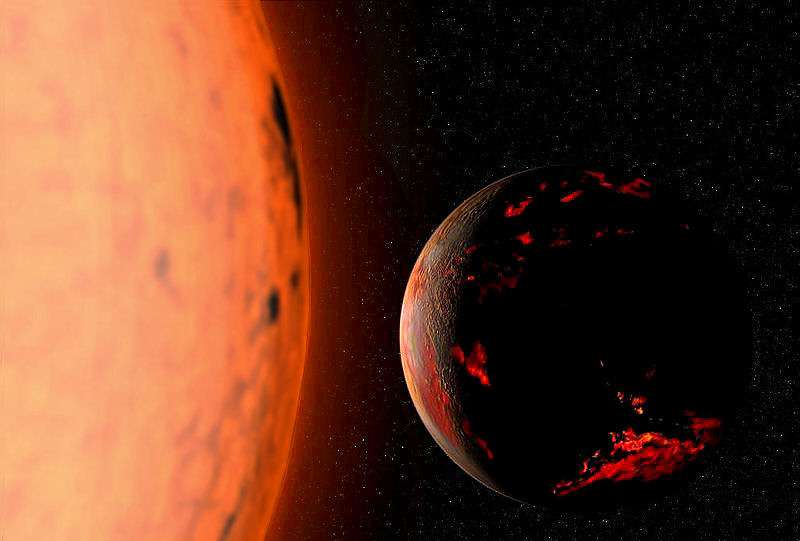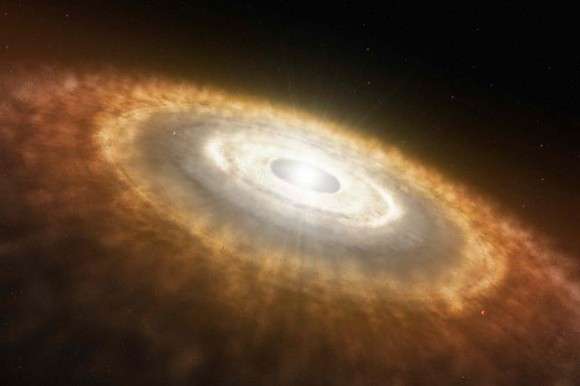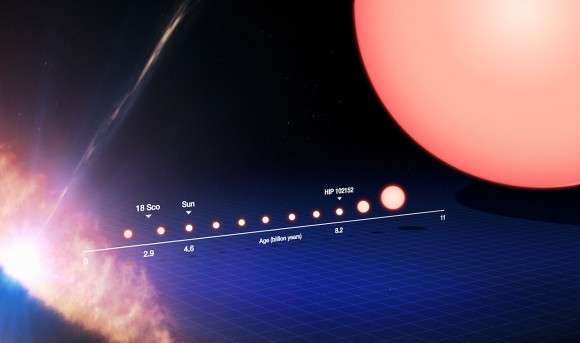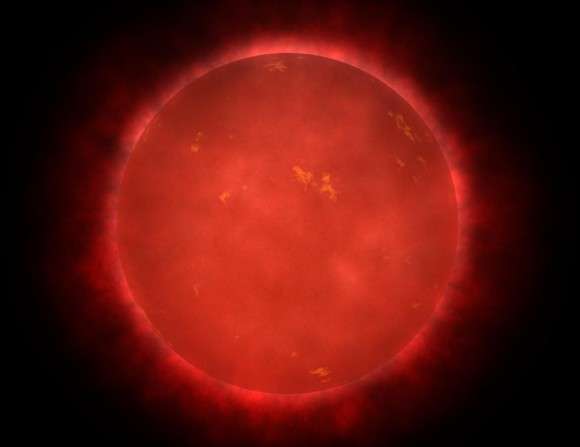Will Earth survive when the sun becomes a red giant?

Since the beginning of human history, people have understood that the sun is a central part of life as we know it. It's importance to countless mythological and cosmological systems across the globe is a testament to this. But as our understand of it matured, we came to learn that the sun was here long before us, and will be here long after we're gone. Having formed roughly 4.6 billion years ago, our sun began its life roughly 40 million years before our Earth had formed.
Since then, the sun has been in what is known as its main sequence, where nuclear fusion in its core causes it to emit energy and light, keeping us here on Earth nourished. This will last for another 4.5 – 5.5 billion years, at which point it will deplete its supply of hydrogen and helium and go through some serious changes. Assuming humanity is still alive and calls Earth home at this time, we may want to consider getting out the way!
The birth of the sun:
The predominant theory on how our sun and solar system formed is known as Nebular Theory, which states that the sun and all the planets began billions of years ago as a giant cloud of molecular gas and dust. Then, approximately 4.57 billion years ago, this cloud experienced gravitational collapse at its center, where anything from a passing star to a shock wave caused by a supernova triggered the process that led to our sun's birth.
Basically, this took place after pockets of dust and gas began to collect into denser regions. As these regions pulled in more and more matter, conservation of momentum caused them to begin rotating, while increasing pressure caused them to heat up. Most of the material ended up in a ball at the center while the rest of the matter was flattened out into a large disk that circled around it.

The ball at the center would eventually form the sun, while the disk of material would form the planets. The sun then spent the next 100,000 years as a collapsing protostar before temperature and pressures in the interior ignited fusion at its core. The sun started as a T Tauri star – a wildly active star that blasted out an intense solar wind. And just a few million years later, it settled down into its current form.
Main Sequence:
For the past 4.57 billion years (give or take a day or two), the sun has been in the main sequence of its life. This is characterized by the process where hydrogen fuel, under tremendous pressure and temperatures in its core, is converted into helium. In addition to changing the properties of its constituent matter, this process also produces a tremendous amount of energy. All told, every second, 600 million tons of matter are converted into neutrinos, solar radiation, and roughly 4 x 1027 Watts of energy.
Naturally, this process cannot last forever since it is dependent on the presence of matter which is being regularly consumed. As time goes on and more hydrogen is converted into helium, the core will continue to shrink, allowing the outer layers of the sun to move closer to the center and experience a stronger gravitational force.
This will place more pressure on the core, which is resisted by a resulting increase in the rate at which fusion occurs. Basically, this means that as the sun continues to expend hydrogen in its core, the fusion process speeds up and the output of the sun increases. At present, this is leading to a 1 percent increase in luminosity every 100 million years, and a 30 percent increase over the course of the last 4.5 billion years.

Approximately 1.1 billion years from now, the sun will be 10 percent brighter than it is today. This increase in luminosity will also mean an increase in heat energy, one which the Earth's atmosphere will absorb. This will trigger a runaway greenhouse effect that is similar to what turned Venus into the terrible hothouse it is today.
In 3.5 billion years, the sun will be 40 percent brighter than it is right now, which will cause the oceans to boil, the ice caps to permanently melt, and all water vapor in the atmosphere to be lost to space. Under these conditions, life as we know it will be unable to survive anywhere on the surface, and planet Earth will be fully transformed into another hot, dry world, just like Venus.
Red Giant Phase:
In 5.4 billion years from now, the sun will enter what is known as the red giant phase of its evolution. This will begin once all hydrogen is exhausted in the core and the inert helium ash that has built up there becomes unstable and collapses under its own weight. This will cause the core to heat up and get denser, causing the sun to grow in size.
It is calculated that the expanding sun will grow large enough to encompass the orbit's of Mercury, Venus, and maybe even Earth. Even if the Earth were to survive being consumed, its new proximity to the the intense heat of this red sun would scorch our planet and make it completely impossible for life to survive. However, astronomers have noted that as the sun expands, the orbit of the planet's is likely to change as well.
When the sun reaches this late stage in its stellar evolution, it will lose a tremendous amount of mass through powerful stellar winds. Basically, as it grows, it loses mass, causing the planets to spiral outwards. So the question is, will the expanding sun overtake the planets spiraling outwards, or will Earth (and maybe even Venus) escape its grasp?
K.-P Schroder and Robert Cannon Smith are two researchers who have addressed this very question. In a research paper entitled "Distant Future of the sun and Earth Revisted" which appeared in the Monthly Notices of the Royal Astronomical Society, they ran the calculations with the most current models of stellar evolution.
According to Schroder and Smith, when the sun becomes a red giant star in 7.59 billion years, it will start to lose mass quickly. By the time it reaches its largest radius, 256 times its current size, it will be down to only 67 percent of its current mass. When the sun does begin to expand, it will do so quickly, sweeping through the inner solar system in just 5 million years.
It will then enter its relatively brief (130 million year) helium-burning phase, at which point, it will expand past the orbit of Mercury, and then Venus. By the time it approaches the Earth, it will be losing 4.9 x 1020 tonnes of mass every year (8 percent the mass of the Earth).
But Will Earth Survive?:

Now this is where things become a bit of a "good news/bad news" situation. The bad news, according to Schroder and Smith, is that the Earth will NOT survive the sun's expansion. Even though the Earth could expand to an orbit 50 percent more distant than where it is today (1.5 AUs), it won't get the chance. The expanding sun will engulf the Earth just before it reaches the tip of the red giant phase, and the sun would still have another 0.25 AU and 500,000 years to grow.
Once inside the sun's atmosphere, the Earth will collide with particles of gas. Its orbit will decay, and it will spiral inward. If the Earth were just a little further from the sun right now, at 1.15 AU, it would be able to survive the expansion phase. If we could push our planet out to this distance, we'd also be in business. However, such talk is entirely speculative and in the realm of science fiction at the moment.
And now for the good news. Long before our sun enters it's red giant phase, its habitable zone (as we know it) will be gone. Astronomers estimate that this zone will expand past the Earth's orbit in about a billion years. The heating sun will evaporate the Earth's oceans away, and then solar radiation will blast away the hydrogen from the water. The Earth will never have oceans again, and it will eventually become molten.
Yeah, that's the good news… sort of. But the upside to this is that we can say with confidence that humanity will be compelled to leave the nest long before it is engulfed by the sun. And given the fact that we are dealing with timelines that are far beyond anything we can truly deal with, we can't even be sure that some other cataclysmic event won't claim us sooner, or that we wont have moved far past our current evolutionary phase.
An interesting side benefit will be how the changing boundaries of our sun's habitable zone will change the solar system as well. While Earth, at a mere 1.5 AUs, will no longer be within the sun's habitable zone, much of the outer solar system will be. This new habitable zone will stretch from 49.4 AU to 71.4 AU – well into the Kuiper Belt – which means the formerly icy worlds will melt, and liquid water will be present beyond the orbit of Pluto.
Perhaps Eris will be our new homeworld, the dwarf planet of Pluto will be the new Venus, and Haumeau, Makemake, and the rest will be the outer "solar system". But what is perhaps most fascinating about all of this is how humans are even tempted to ask "will it still be here in the future" in the first place, especially when that future is billions of years from now.
Somehow, the subjects of what came before us, and what will be here when we're gone, continue to fascinate us. And when dealing with things like our sun, the Earth, and the known Universe, it becomes downright necessary. Our existence thus far has been a flash in the pan compared to the cosmos, and how long we will endure remains an open question.
Provided by Universe Today



















